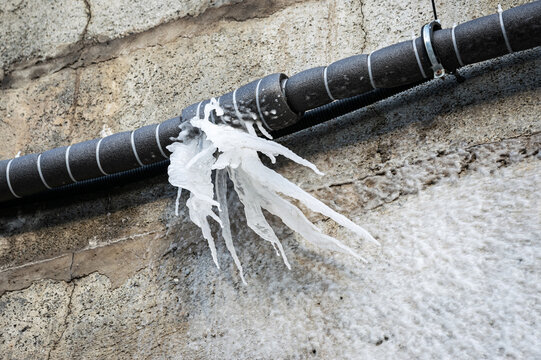Important Advice to Avoid Frozen Plumbing in Winter
Important Advice to Avoid Frozen Plumbing in Winter
Blog Article
This post down the page relating to Preventing and dealing with frozen pipes is quite captivating. Read it yourself and see what you think about it.

Cold weather can wreak havoc on your plumbing, specifically by freezing pipes. Below's just how to stop it from taking place and what to do if it does.
Introduction
As temperatures drop, the threat of icy pipes increases, potentially leading to costly repair work and water damage. Recognizing exactly how to avoid frozen pipelines is essential for home owners in cold environments.
Recognizing Frozen Pipelines
What triggers pipelines to freeze?
Pipes freeze when exposed to temperatures below 32 ° F (0 ° C) for extended durations. As water inside the pipelines freezes, it increases, putting pressure on the pipe walls and possibly triggering them to rupture.
Dangers and damages
Icy pipes can cause water disturbances, building damages, and expensive repairs. Ruptured pipelines can flood homes and cause extensive architectural damage.
Indicators of Frozen Piping
Determining icy pipes early can stop them from bursting.
Exactly how to determine frozen pipes
Seek lowered water circulation from faucets, unusual odors or sounds from pipelines, and noticeable frost on revealed pipes.
Avoidance Tips
Insulating prone pipes
Wrap pipelines in insulation sleeves or utilize warm tape to shield them from freezing temperature levels. Concentrate on pipes in unheated or exterior locations of the home.
Heating techniques
Maintain interior rooms appropriately warmed, specifically areas with plumbing. Open cupboard doors to enable warm air to flow around pipes under sinks.
Safeguarding Exterior Plumbing
Yard pipes and outside faucets
Detach and drain pipes yard hoses prior to winter. Set up frost-proof faucets or cover exterior faucets with protected caps.
What to Do If Your Pipelines Freeze
Immediate actions to take
If you believe icy pipes, keep faucets open up to eliminate stress as the ice thaws. Utilize a hairdryer or towels soaked in hot water to thaw pipes gradually.
Long-Term Solutions
Architectural modifications
Consider rerouting pipes far from exterior wall surfaces or unheated areas. Include added insulation to attics, cellars, and crawl spaces.
Upgrading insulation
Purchase high-quality insulation for pipes, attics, and wall surfaces. Appropriate insulation helps preserve consistent temperatures and decreases the threat of frozen pipes.
Final thought
Avoiding icy pipelines requires aggressive measures and fast feedbacks. By recognizing the reasons, indications, and preventive measures, home owners can secure their pipes during cold weather.
6 Proven Ways to Prevent Frozen Pipes and Protect Your Home
Disconnect and Drain Garden Hoses
Before winter arrives, start by disconnecting your garden hoses and draining any remaining water. Close the shut-off valves that supply outdoor hose bibs and leave the outdoor faucet open to allow any residual water to drain. For extra protection, consider using faucet covers throughout the colder months. It’s also important to drain water from any sprinkler supply lines following the manufacturer’s directions.
Insulate Exposed Pipes
Insulating your pipes is an effective way to prevent freezing. Pipe insulation is readily available at home improvement stores and is relatively inexpensive. Pay close attention to pipes in unheated areas such as the attic, basement, crawl spaces, or garage. Apply foam insulation generously to create a buffer against the cold. You can also wrap your pipes in heat tape or thermostat-controlled heat cables for added warmth.
Seal Air Leaks
Inspect your home for any cracks or openings that could let in cold air. Seal any holes around the piping in interior or exterior walls, as well as the sill plates where your home rests on its foundation. Additionally, make sure to keep your garage door closed unless you’re entering or exiting. Leaving it open creates a significant air leak that can lead to frozen pipes.
Allow Warm Air Circulation
During cold snaps, it’s essential to allow warm air to circulate evenly throughout your home. Leave interior doors ajar to promote better airflow. Open kitchen and bathroom cabinets to help distribute heat consistently around the rooms. If you have small children or pets, be sure to remove any household chemicals or potentially harmful cleaners from open cabinets for safety.
Let Faucets Drip
A small trickle of water can make a big difference in preventing ice formation inside your pipes. When temperatures drop significantly, start a drip of water from all faucets served by exposed pipes. This continuous flow helps prevent the water from freezing. Additionally, running a few faucets slightly can relieve pressure inside the pipes, reducing the chances of a rupture if the water inside does freeze.
https://choateshvac.com/6-proven-ways-to-prevent-frozen-pipes-and-protect-your-home/

I hope you liked our article about Winter Plumbing Precautions: Preventing Frozen Pipes. Thanks for taking time to read through our article. Those who enjoyed our post plz be sure to share it. Many thanks for being here. Please check up our blog back soon.
Schedule A Service Report this page